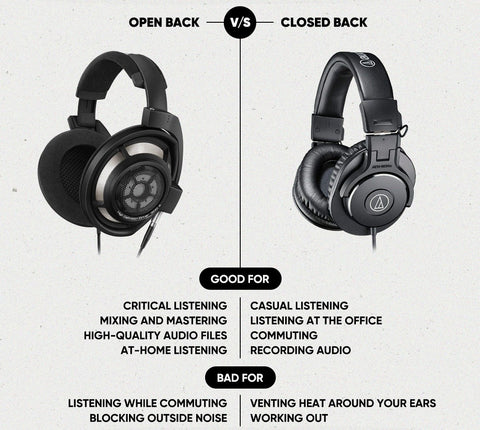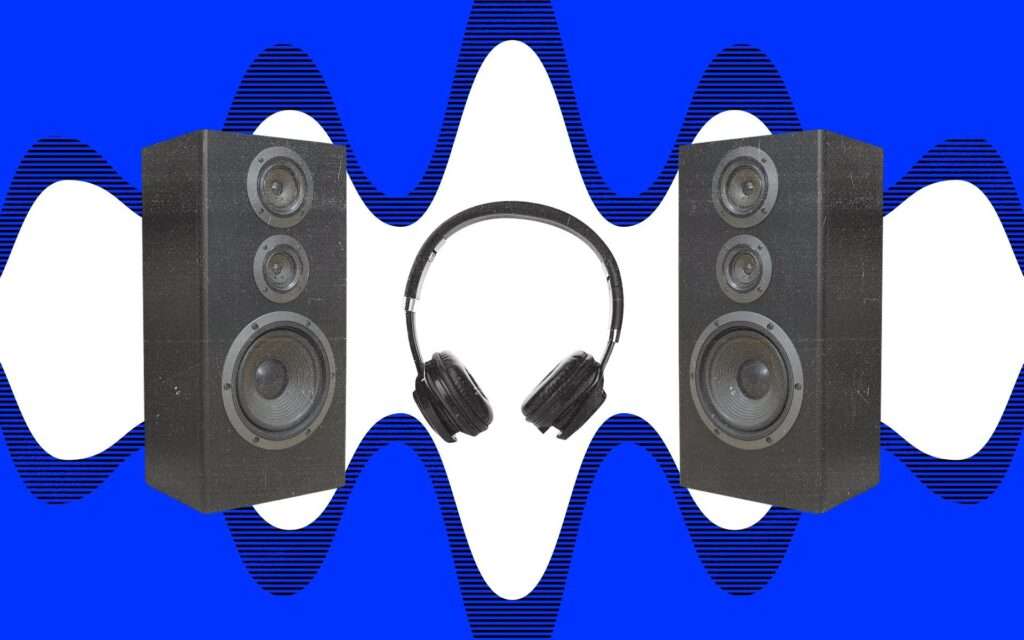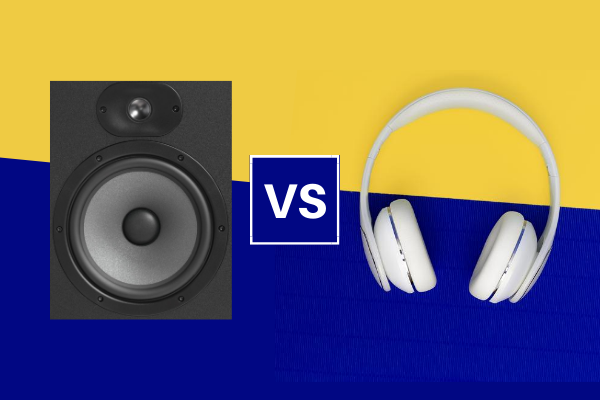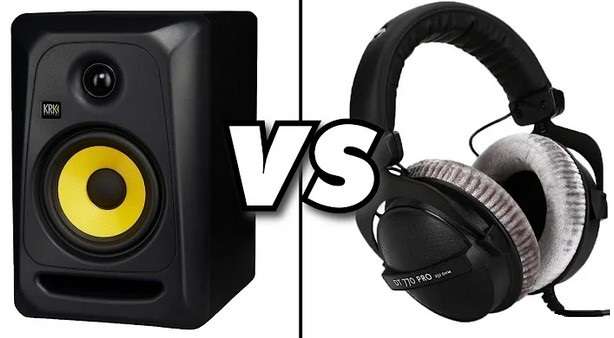When focusing on creating top-notch sound, the debate between studio headphones vs monitors has been a hot topic among audio professionals. Each has its unique advantages and drawbacks, making it essential to understand the differences before deciding on your studio setup.
Studio headphones provide personal, detailed audio, while monitors offer a room-wide soundstage. Headphones excel in isolation; monitors allow for spatial referencing.
Before delving into the specifics of studio headphones vs monitors, let’s weigh the pros and cons of each to determine which option best suits your needs. Both studio headphones and monitors play a crucial role in the production process, offering distinct benefits that cater to different aspects of audio engineering and mixing.
Studio headphones are favored for their ability to deliver precise, clear sound directly to your ears, making them ideal for detailed editing and mixing in noisy environments.
On the other hand, monitors are essential for accurate sound production in a studio setting, allowing producers to hear how recordings will sound in a real-world environment.
Both tools are crucial for sound engineers, with the choice depending on the listening context, personal preference, and specific audio tasks. Understanding the strengths of each can guide you to better sound production and a more efficient studio setup.
The Role Of Sound In Music Production
When we talk about producing music, sound quality is not just important; it’s everything. A clear mix can make or break a track. Producers rely on precise audio tools to sculpt their masterpieces.
Two essential tools are studio headphones and monitors. Each serves a specific role in shaping the final sound that listeners enjoy. Let’s explore the importance of these tools.
Crucial Elements Of A Clear Mix
In crafting a clean and polished audio mix, certain elements are non-negotiable. Balanced frequencies, accurate stereo imaging, and detailed dynamics headline these essentials. Studio headphones and monitors allow producers to hone these aspects meticulously.
- Balanced Frequencies: Ensuring that no single frequency overpowers others.
- Stereo Imaging: Creating an accurate soundstage where each instrument sits in the right place.
- Dynamics: Keeping the balance between the loudest and softest sounds.
The Journey Of Sound From Creation To Consumption
The life cycle of a song, from the studio to the listener’s ears, is fascinating. The journey begins with sound creation, where producers use instruments and effects. Studio headphones and monitors then play their roles:
| Studio Headphones | Monitors |
| Intimate Listening: Allows for a closer inspection of sound, delivering direct audio without room acoustics affecting the outcome. | Authentic Space: Offers a true representation of how sound behaves in a physical space, which is crucial for mixed decisions. |
Once mixes are finalized using these tools, the song heads out to meet the audience, transformed through various devices and environments.

Credit: www.therevolverclub.com
Studio Headphones Defined
When delving into the world of music production, the tools used can make all the difference. Studio headphones play a vital role. Unlike regular headphones, studio ones are designed for clarity and precision.
They allow producers to hear every detail of their work, and pick out nuances that regular headphones might hide. This perk makes them essential for mixing and mastering tracks. Let’s explore what sets high-quality studio headphones apart.
Characteristics Of High-quality Studio Headphones
- Flat Frequency Response: Ensures accurate sound reproduction.
- Comfort: Padded and adjustable for long sessions.
- Durability: Built to last through extensive use.
- Sound Isolation: Blocks external noises effectively.
- Impedance: Matches studio equipment for optimal sound.
- Cable Quality: Durable and long enough for freedom of movement.
Pros And Cons Of Using Headphones In The Studio
| Pros | Cons |
| Detail Recognition Portability Affordable Alternative Good for Silent Practice | Ear Fatigue Less Natural Soundstage Isolation from Environment Varied Impedance Levels |
Understanding Studio Monitors
Understanding Studio Monitors begins with recognizing their role in audio production. These are the workhorses in a studio setup. They give an exact representation of sound. Music professionals rely on them to get the truest audio feedback.
Key Features Of Reliable Studio Monitors
When searching for studio monitors, certain features stand out:
- Flat Frequency Response: This ensures all frequencies playback at the same level.
- Driver Size: Larger drivers can reproduce lower frequencies more effectively.
- Active vs. Passive: Active monitors have built-in amplifiers, while passive ones require external amps.
- Input Types: They should accept different audio inputs like XLR, TRS, or RCA.
- Room Correction Controls: These help the monitors adapt to the room’s acoustic characteristics.
Advantages And Drawbacks Of Monitors For Mixing
Studio monitors shine in several areas:
- Honest Sound: A clear and neutral sound picture is crucial for mixing.
- Detail Resolution: Monitors highlight the small details in music.
- Stereo Imaging: Good monitors offer a precise 3D space representation.
However, they also pose challenges:
- Room Dependency: The sound may change with the room’s acoustics.
- Price: High-quality monitors can be expensive.
- Sweet Spot: The prime listening area is often limited in size.
Comparing Sound Fidelity And Accuracy
Understanding the nuances between studio headphones and monitors is vital for audio professionals. Picking the right equipment affects sound fidelity and accuracy. This difference shapes how audio appears to listeners. It influences crucial production decisions. Let’s dive deeper into these differences.
How Headphones And Monitors Translate Sound Differently
Headphones offer a direct and intimate listening experience. They bring sound right to your ears without room-acoustic interference. This setup comes with both merits and limitations.
- Isolation: Headphones block out external noise, perfect for focused listening.
- Stereo Image: They can exaggerate stereo separation, leading to a wide soundstage illusion.
- Frequency Response: Headphones tend to have a varied frequency response, boosting or cutting certain frequencies.
In contrast, monitors offer a realistic sound representation in a controlled environment.
- Space Interaction: Monitors interact with room dimensions and acoustics, giving a more accurate spatial impression.
- Natural Crossfeed: They allow for natural crossfeed between the ears, leading to a more cohesive stereo image.
- Low-End Representation: Monitors often reproduce lower frequencies more accurately than headphones.
Impact On Mixing Decisions And Mastering
Mixing and mastering decisions vary based on what you use to listen. Headphones might make you adjust levels and panning differently. Monitors let you hear how sounds blend in space.
| Equipment | Mixing Impact | Mastering Impact |
| Headphones | Precise level control | Hyper detailed edits |
| Monitors | Real-world mix balance | Room-influenced mastering |
Headphones might lead to overcompensation in mixing, especially in the bass. Monitors can guide more balanced decisions, reflecting how music will sound in typical listening environments.
Considerations For Home And Professional Studios
When setting up a studio, be it at home or professionally, your choice of audio playback gear is pivotal. Studio headphones and monitors each play a role in how sound gets analyzed and produced, influencing the final audio experience.
Choosing the appropriate setup relies on several factors, including available space and budget. Let’s delve into what you should consider before making your pick.
Space And Acoustics: Choosing Between Headphones And Monitors
Every studio has its unique characteristics, particularly when it comes to space and acoustics. The choice between headphones and monitors depends on the room’s characteristics and how sound behaves within it.
- Headphones are great for tight spaces, immersing you in sound without room influence.
- Monitors need more space but provide a realistic audio experience, critical for professionals.
Monitors work best in rooms treated for sound. For smaller or untreated spaces, headphones might be the better choice. Understand your acoustical environment before making a decision.
Budget Constraints And Investment Priorities
Studios operate within budgets, and gear costs can add up quickly. It’s crucial to prioritize investments that elevate your studio’s performance.
| Gear Type | Cost | Investment Value |
| Headphones | Lower | High for personal use and precision editing |
| Monitors | Higher | Essential for professional mixing and mastering |
Assess your funds and allocate them where they benefit most. For beginners or home setups, high-quality headphones may suffice. Professionals should consider investing more in monitors for the best sound representation.

Credit: splice.com
The Hybrid Approach For Optimal Results
For music production, mixing balance is key. A hybrid approach using both studio headphones and monitors delivers optimal results. This method provides detailed sound from headphones and a room’s acoustics from monitors. Learn to fuse both tools effectively in your recording setup.
Integrating Headphones And Monitors Into A Recording Setup
Master both studio headphones and monitors for a robust sound experience. Below are the steps to blend these audio tools for precision.
- Place the monitors at the level of your ears, forming an equilateral triangle with your listening position.
- Use headphones to catch subtle audio details during editing.
- Combine the outputs to get a comprehensive sound profile.
Ensure the headphones and monitors are compatible with your audio interface. Check that your space is well-acclimated acoustically for monitor playbacks.
Best Practices For Switching Between Headphones And Monitors
Switching between headphones and monitors can be seamless. Follow these best practices:
| Activity | Headphones or Monitors? | Reason |
| Initial Mixing | Monitors | Provides room acoustic context |
| Detail Work | Headphones | Fine-tunes the sound |
| Final Checks | Both | Guarantees a balanced mix |
Listen at different volumes. This tests the mix’s sound at various levels.
For critical listening, use headphones to catch nuances. Monitors should then validate these adjustments in a real-world environment.
Take consistent breaks. This practice prevents ear fatigue which can lead to a skewed mix.
Final Recommendations For Producers And Audio Engineers
As a producer or audio engineer, the gear you choose impacts the quality of your work. You require tools that highlight all nuances and details in the audio. Here, we give final recommendations for those picking studio headphones and monitors.
Guidelines For Selecting Studio Headphones And Monitors
Selecting the right studio headphones and monitors is essential. Your choice can make or break your audio production. The following tips will help you make an informed decision:
- Frequency Response: Look for a wide range; it ensures all notes are clear.
- Comfort: Producers and engineers work for long hours. Comfort is key.
- Open-back vs. Closed-back: Open-back for mixing; closed-back for recording.
- Monitor Size: Match monitor size with your studio space.
- Power: Ensure monitors are powerful enough for your studio.
Long-term Considerations For Gear Maintenance
Maintaining your gear preserves its life and your sound quality. Here’s how to keep your equipment in top shape:
- Clean Regularly: Dust-free gear prevents audio interference.
- Cable Care: Store cables properly to avoid damage.
- Humidity Control: Keep moisture low to protect the equipment.
- Wear and Tear: Frequently inspect for indications of damage, and make repairs as necessary.

Credit: www.aimm.edu
Frequently Asked Questions For Studio Headphones Vs Monitors
Is It Better To Mix On Studio Monitors Or Headphones?
Mixing on studio monitors is generally better for accurate sound representation. Headphones can be useful for detail work or in noisy environments.
Is Mastering Headphones Better Than Monitors?
Mastering monitors is generally preferred due to the wider frequency range and stereo field accuracy. Headphones can mask mixing issues and do not translate well to other listening environments.
Is It Better To Produce With Headphones Or Speakers?
Producing music with headphones offers precise sound monitoring, ideal for detailed work and noise-prone environments. Conversely, speakers provide a more natural listening experience and spatial awareness, essential for gauging how music will sound in real-life settings. Both have unique advantages for different production stages.
Are Studio Headphones Good For Normal Use?
Yes, studio headphones are suitable for everyday use, offering high-quality sound and sturdy build, ideal for music enthusiasts. They provide precise audio and comfort, making them versatile for various listening activities.
Conclusion
Choosing between studio headphones and monitors depends on your audio needs. Studio headphones offer intimacy and detail, ideal for focused editing. Monitors ensure accurate sound representation in a controlled environment, perfect for mixing. Each has unique benefits, aligning with different aspects of sound production.
Therefore, consider your priorities and select accordingly for optimal audio results.

A passionate tech blogger and the founder of Best Tech View, a dynamic platform dedicated to all things technology. With a keen interest in the tech, Ahmad strives to provide insightful and engaging content on the latest tech trends, and breakthroughs.

